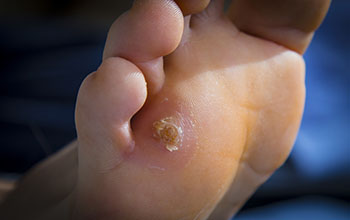
What is a Corn?
If your feet experience repeated rubbing or pressure, whether from tight shoes or standing for long hours, you might develop hardened, raised layers of skin known as corns. Corns are your skin's way of protecting itself from this friction or pressure. These uncomfortable spots can appear in various places on your feet, such as between your toes, on top of your toes, under the toenail, or on the sides and bottoms of your feet.
Symptoms of a Corn
Though corns and calluses are often confused, they are not the same. Corns tend to be smaller and more deeply rooted, featuring a hard core surrounded by swollen skin. They are generally more painful compared to calluses. Corns can also present various other signs, such as:
- A circular shape
- A yellow, white, or grayish hue
- Uneven or bumpy skin
- Tenderness when touched
- Discomfort when wearing shoes
- A sometimes rubbery feel
Different Types of Corns
Corns are categorized into three distinct types: hard, soft, and seed corns.
Hard corns. These are the most prevalent types of corns. These are small, concentrated areas that may exhibit a yellowish hue
Soft corns. These are commonly found between the toes, have a rubbery texture and may appear white or gray.
Seed corns. These are smaller and typically develop on the soles of the feet.
Can Corns Be Prevented?
The best way to prevent corns from forming or reappearing is to eliminate friction on your feet. Here are some additional measures you can take:
- Choose shoes that fit well and do not rub against your skin uncomfortably.
- Regularly trim your toenails to avoid them pressing against the ends of your shoes, creating pressure points.
- Maintain clean and moisturized feet to prevent dryness, which can lead to friction.
How Are Corns Treated?
Corns may disappear if the pressure and friction causing them are eliminated. Various methods can help alleviate pressure and friction, thereby reducing the pain associated with corns.
- Corn pads. These are adhesive pads shaped similarly to donuts, placed over the corn to shift pressure away from it
- Soaking the corn. Soaking a corn in water for 10 minutes can help soften it. This simple method can make the corn easier to manage and reduce discomfort.
- Filing the corn. Using a pumice stone dipped in warm water can help gently file down the corn with circular motions. However, this method is not suitable for individuals with diabetes, compromised skin, or circulatory issues. It's crucial to avoid attempting to cut or shave the corn at home.
- Moisturizing the corn. Applying a cream containing salicylic acid may assist in gradually dissolving the layers of the corn. However, individuals with diabetes, compromised skin, or circulatory issues should avoid using this type of lotion.
If you're dealing with a persistent, highly painful, or inflamed corn, it's best to seek treatment from a podiatrist. They possess a range of professional methods to effectively remove the corn and alleviate discomfort and inflammation.

